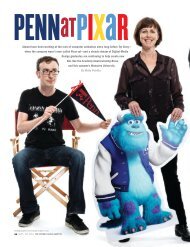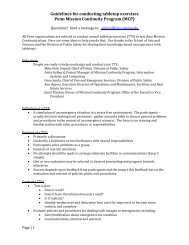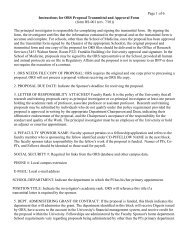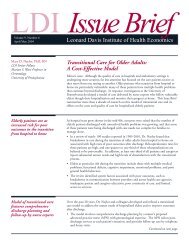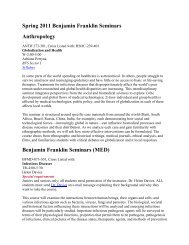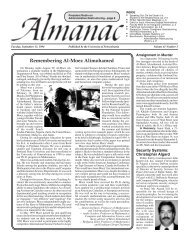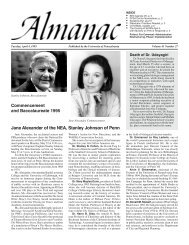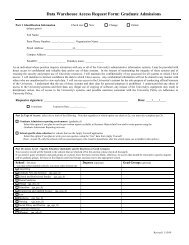Download this article (PDF) - University of Pennsylvania
Download this article (PDF) - University of Pennsylvania
Download this article (PDF) - University of Pennsylvania
Create successful ePaper yourself
Turn your PDF publications into a flip-book with our unique Google optimized e-Paper software.
BY<br />
the time Nathaniel’s My Architect was released in apart—“honed, rather than sawn or flamed or so forth, because<br />
2003 and sparked new interest in the memorial, Kahn knew that they would take the light and do something<br />
a movement was growing to take back the site and absolutely magical with it. So we said, ‘No, you can’t do that,<br />
build something else on it. In October 2004 a concerned neighbor<br />
and philanthropist named Jane Gregory Rubin asked understanding that there were lots <strong>of</strong> little bits and pieces <strong>of</strong><br />
and you have to go back on <strong>this</strong>.’ That was the beginning <strong>of</strong><br />
Cooper Union to mount an exhibition with the implicit idea stuff that had not carried through from ’74.”<br />
<strong>of</strong> kick-starting a fundraising drive.<br />
One <strong>of</strong> the most delicate issues concerned inscriptions.<br />
“It was really a last-ditch effort to say, if we don’t do <strong>this</strong>, <strong>this</strong> [site] Not only had designs been drawn up showing the words from<br />
is going to be given away for some other purpose,” says Pollara, Roosevelt’s speech written on the walls <strong>of</strong> the Room, but at one<br />
who was then working in Cooper Union’s architectural archives. point the names <strong>of</strong> major donors were going to be inscribed<br />
She co-curated the exhibition, “Coming to Light: The Louis I. Kahn in sensitive locations as well.<br />
Monument to Franklin D. Roosevelt for New York City.”<br />
“I queried people [from Kahn’s <strong>of</strong>fice] who had worked on <strong>this</strong>,”<br />
The exhibition did its job. The late Arthur Ross W’31 Hon’92 says Whitaker. “One said, ‘The whole point was not to have inscriptions.<br />
So it’s not even worth doing if you’re going to do that.’” He<br />
gave the first $2.5 million, and an <strong>article</strong> in The New York<br />
Times prompted the Alphawood Foundation to give $600,000 also found notes from a meeting in which Kahn himself had said<br />
in seed money—then, later, $10 million. In August 2006, FDR that any inscriptions from the speech would “best be displayed<br />
Four Freedoms Park asked Pollara to head the project. around the sculpture,” not the “columnar masses” <strong>of</strong> the walls.<br />
“It was really unclear whether we would be able to actually pull “If you look at the drawings from 1975, the back side <strong>of</strong> the<br />
<strong>this</strong> <strong>of</strong>f—for financial and political reasons, and regulation reasons,”<br />
says Pollara, noting that Roosevelt Island represents a “very inscribed,” says Pollara. “So thankfully Bill and Nathaniel made<br />
sculpture niche is the only place where any text was to be<br />
complicated jurisdictional problem” for builders. The remarkable a very clear case that that was not the right thing to do.”<br />
William vanden Heuvel raised roughly two-thirds <strong>of</strong> the $53 million The inscriptions were dropped—but only at the last minute, and<br />
budget from private sources, with another $12 million coming from not without blowback. Two <strong>of</strong> the biggest donors, the Alphawood<br />
the city and $6 million from the state—a “staggering” achievement, Foundation and the Reed Foundation, sued for breach <strong>of</strong> contract<br />
Pollara says, especially in a time <strong>of</strong> economic collapse.<br />
and at the last minute tried—unsuccessfully—to halt the dedication<br />
There were still lingering issues related to the park’s design, ceremony. Part <strong>of</strong> the suit has been settled, and the names <strong>of</strong> major<br />
including the ramps and other proposed changes for handicapped<br />
accessibility.<br />
The ramps had been dropped before construction began.<br />
donors will be near the entrance to the park.<br />
“There was a lot <strong>of</strong> back and forth as to whether <strong>this</strong> was “Thankfully we were able, at the 11th hour, to turn the design<br />
being completed the way it should have been,” says Rubenstein. back to the original Kahn design and thereby preserve that<br />
He had left Mitchell/Giurgola by then and gone out on his own, very important experience <strong>of</strong> the Room,” says Pollara. “I’m just<br />
but when Sue Ann Kahn approached him in 2008 to help out thankful we didn’t build the wrong thing. It would have been a<br />
as an unpaid consultant, he agreed.<br />
complete disaster.”<br />
“There was a sense that things were getting watered down<br />
in terms <strong>of</strong> the detailing—subtly, but significantly,” he adds. Of the unresolved issues at Four Freedoms Park, the most jarring<br />
“And without anyone realizing they were doing things in error, is the entrance scheme. Visitors now have to go past the fenced<strong>of</strong>f<br />
Renwick Ruin and through a “no-man’s land” controlled<br />
the new set <strong>of</strong> specifications had an awful lot <strong>of</strong> things that<br />
were not the way that Kahn would have done them. There was by RIOC to reach Kahn’s masterpiece, explains Pollara. The<br />
no one in that [Mitchell/Giurgola] <strong>of</strong>fice who knew anything problem is exacerbated by the fact that the original 13-acre<br />
about Lou Kahn, outside <strong>of</strong> looking at pictures.”<br />
site was “bifurcated when we started <strong>this</strong> effort,” and there<br />
On March 29, 2010, construction began on what is said to has been virtually no coordination between the two organizations.<br />
Though she found that frustrating at first, she now sees<br />
be the heaviest stone-setting job ever undertaken in New York<br />
City. (The granite blocks were too heavy for the Roosevelt Island it as an opportunity.<br />
Bridge, and had to be ferried to the island from northern New “Now that we’ve got all <strong>this</strong> information [in the Architectural<br />
Jersey.) Pollara has praised her “passionate and dedicated construction<br />
team” for executing the plans to a tolerance <strong>of</strong> one-<br />
try to build out the rest <strong>of</strong> the Kahn vision,’” she says. “It would<br />
Archives], we can really go back and evaluate, and say, ‘Look, let’s<br />
eighth <strong>of</strong> an inch, but it wasn’t exactly a painless process. be so wonderful to reestablish the grove <strong>of</strong> trees.” (Ultimately,<br />
“There were so many times at the weekly construction meetings they’ll need to coordinate with RIOC and Cornell <strong>University</strong>,<br />
where the guys would say, ‘Well, it doesn’t matter, because you won’t which is putting together a master plan for its Cornell Tech<br />
see it,’” recounts Pollara. “Finally I said, ‘The next person who says campus to be located just north <strong>of</strong> the RIOC parcel.)<br />
that is fired. I’m done hearing that. You do know the difference.’” Pollara is also quite open to the idea <strong>of</strong> Pattison’s canal—which,<br />
Take the massive granite columns. A granite expert hired she points out, would be on what is now a flood plain.<br />
by Mitchell/Giurgola recommended making the pieces square “Right now we’re undertaking to do some feasibility studies<br />
and having the same finish on all four sides, so that if there and some schematic programming and schematic design,” she<br />
was a problem with one face, it could be turned around while adds. “In my opinion there isn’t any idea <strong>of</strong>f the table.”<br />
the crane was moving it. “That got written into the spec that Furthermore, since the original vision provided for a reception<br />
hall and facilities—first in the House within the Garden,<br />
was about to go out for bid,” says Rubenstein. But the original<br />
project plans had called for those faces to be an inch then more vaguely in the Renwick Ruin area—Pollara adds:<br />
48 MARCH | APRIL 2013 THE PENNSYLVANIA GAZETTE



